Know Your Tree
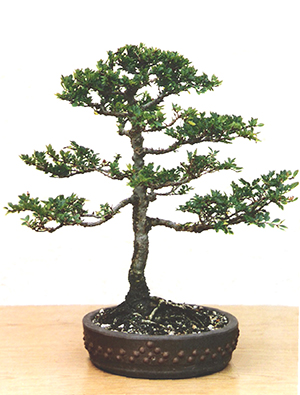
A Yatsubusa Elm
by Lew Buller
As usual before writing an article, I checked the Internet for information. The few Yatsubusa Elm trees shown were both expensive and misshapen. Misshapen because it takes a long time to learn how to grow this tree, and expensive because the growth is so slow.
I wouldn’t suggest starting this tree from a cutting unless you are under 50 years of age or have a successor in mind. Wikipedia had almost nothing in January 2015 so I added some information from the material that follows.

In pine form, inner growth dies back
The Ulmus parvifolia ‘Yatsubusa’ in this article was a barely rooted cutting when I traded a shohin-sized slab for it in 1991. I translated yatsubusa as “many-budded,” but according to Brussel’s Bonsai, yatsubusa means “. . . a particular type of dwarf form. Internodal distances are shorter than commonly found on a dwarf, and nodes have more buds than usual, resulting in dense growth.” “Witches’ brooms” growing on pines and other trees have similar forms.1
Like many beginning bonsai enthusiasts, I wanted one of everything and took the Yatsubusa home just to see how it would grow. It grew slowly; 14 years later, it had a trunk diameter of only one and one-sixteenth inches. My cutting came from stock that made its way down from Lodi, California, where Seiju-En was located, through Los Angeles, and finally to San Diego. By 2005, it was possible to get one from commercial sources, with prices ranging from $5 for a 2 3/4” pot to $350 for a tree with the same trunk diameter as mine. Ten years later it was more difficult to get one, probably because people had discovered how long it took to develop.
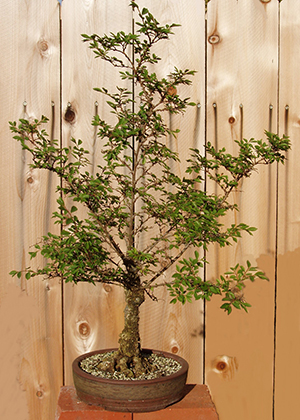
Before the second beheading.
As well as learning to grow trees, I had to learn to style them, so I just let it grow while I learned. In retrospect, I would not have planted the tree off-center as the roots on the side with less space developed more slowly than the others. During late fall and early winter, the trunk was wired with aluminum wire to keep it straight; the wire was removed just after the tree began to leaf out in the spring in early February. It slowly developed a nice set of roots, but the branch placement left something to be desired. Having started to learn the pine form, what little wiring I did on the branches was to create an elm in a pine form.
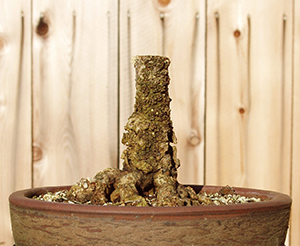
14 year old nebari
By 2000, I knew that elms could have all branches removed and they would re-grow new ones, so I did that. And for good measure, I cut the top off, thinking to increase taper. The new branches did not come in with any better spacing, and while the top of the trunk re-sprouted, the new top went off at an angle and did not look as if it would cover the scar. I did not wire the new branches but let them grow in natural elm form, not in pine form. The difference is obvious.
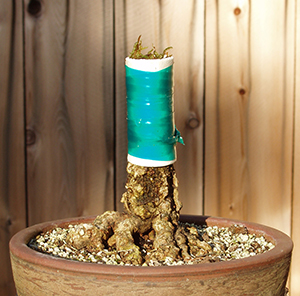
Bandaged up.
I let it re-grow, to build both strength and trunk diameter. This elm is deciduous but leafs out early, and by the end of March 2005, it was fully leafed out. At that time, I decided to cut the branches and top off again to see if I could develop a broom-form elm. Usually I cut on a slant, to prevent water from collecting on the cut and starting the rotting process, but I did not in this case. The cut was made below the knob that had formed when the elm had regrown a new top the first time, and it was made as level as possible as I did not want any side of the new tree to have an advantage in sprouting new buds. The top of the cut was 2 ½ inches from the top of the soil.
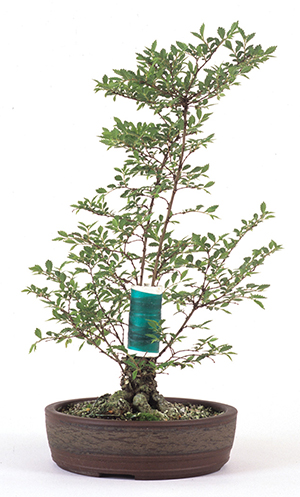
Two major branches
To keep the new buds (later to become branches) close to the trunk, I fitted a piece of Styrofoam cut from a drinking cup carefully around the tree, leaving very little space for the buds to erupt. The Styrofoam extended about 5/8” above the cut, enough to control the new buds but not enough to kill them. The Styrofoam was wrapped with stretchable green plastic tape, a small amount of sphagnum moss was inserted in the top to keep the upper bark moist, and the tree was set in part shade and watered along with the rest of my bonsai. After there were signs of new buds at the top, I removed the sphagnum moss; otherwise, the new branches would etiolate (grow tall and spindly) to reach the sunlight.
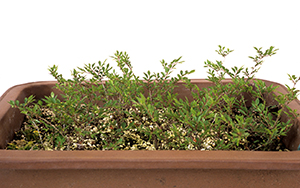
Cuttings in peat and perlite
Because this elm is such a delightful little tree, the second time I cut the top off, I kept all the branches I had removed and turned them into cuttings I could pass on to friends who are in bonsai for the long term–remember, this tree grows very slowly and is not for people who want instant bonsai. The makeshift greenhouse where I kept them moist was simply a bonsai pot with a wire frame above it that held a plastic bag away from the cuttings and the planting medium was a 50/50 mix of fine peat and perlite. Peat has an antibacterial effect and as little as 10% would have been enough. Perlite provided good drainage and moisture retention.
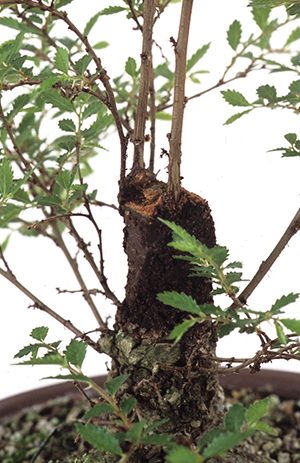
Four new branches.
The reason for cutting all branches off is that if one branch had been left, the tree would have used all its resources to develop that one branch rather than send out new buds. By the end of April, when I had finished spring transplanting, the elm had four new branches peeping out over the top of the Styrofoam. They were evenly spaced, except that the side on which the roots were less developed had no fifth branch. There were also small branches developing lower down on the trunk. Earlier, I had scratched such branches off with a fingernail, because I wanted all of the tree’s resources used to grow branches at the top. Now, I let the lower branches start growing before I scratched them off; the scarred areas make interesting little bumps on the trunk of the tree.
The Styrofoam came off April 16, 2006, 13 months after it had been put on. It had kept the growth of new branches vertical, very close to the trunk, without creating a bulge in the trunk. Two major new branches as well as two smaller ones had grown right at the top of the cut. The trunk is only 1 1/16” wide, so you can imagine how small the new branches were. One small branch died, but three remained. The cambium grew all around the top of the cut and to stimulate it to continue to grow, I scraped it all around the wound. It was healing over when the last photo was taken.
It would be nice to show a photo of the tree in final form, but that will have to wait another 10-15 years. Here’s what’s planned for the tree’s future. First, I will let the present branches grow as much as possible to heal over the trunk cut. When I removed the top, it would have been possible to cut a V in the trunk and force the sides together to give the appearance of some taper. Such cuts, however, do not always heal and result in quite a bit of dead wood just where the branches start. Instead, I will take some of the cuttings that grew–almost all rooted–transplant them to separate small pots and inarch graft them to the areas around the cut where I would like to have new branches as well as more growth to cover the cut. As you can tell from the photos, elms can be very forgiving of harsh treatment.
Carl Young, who discovered and introduced the Seiju elm, is given credit for introducing the Yatsubusa elm to bonsai growers in California. Various sources identify it as a cultivar of Ulmus parvifolia ‘Lacebark’, and it may have been imported from Japan; that part is not clear. While the Lacebark tops out at 45 feet, the Yatsubusa tops out at six feet, and does so slowly. It is generally free of disease and pests, including Dutch elm disease and elm leaf beetles.
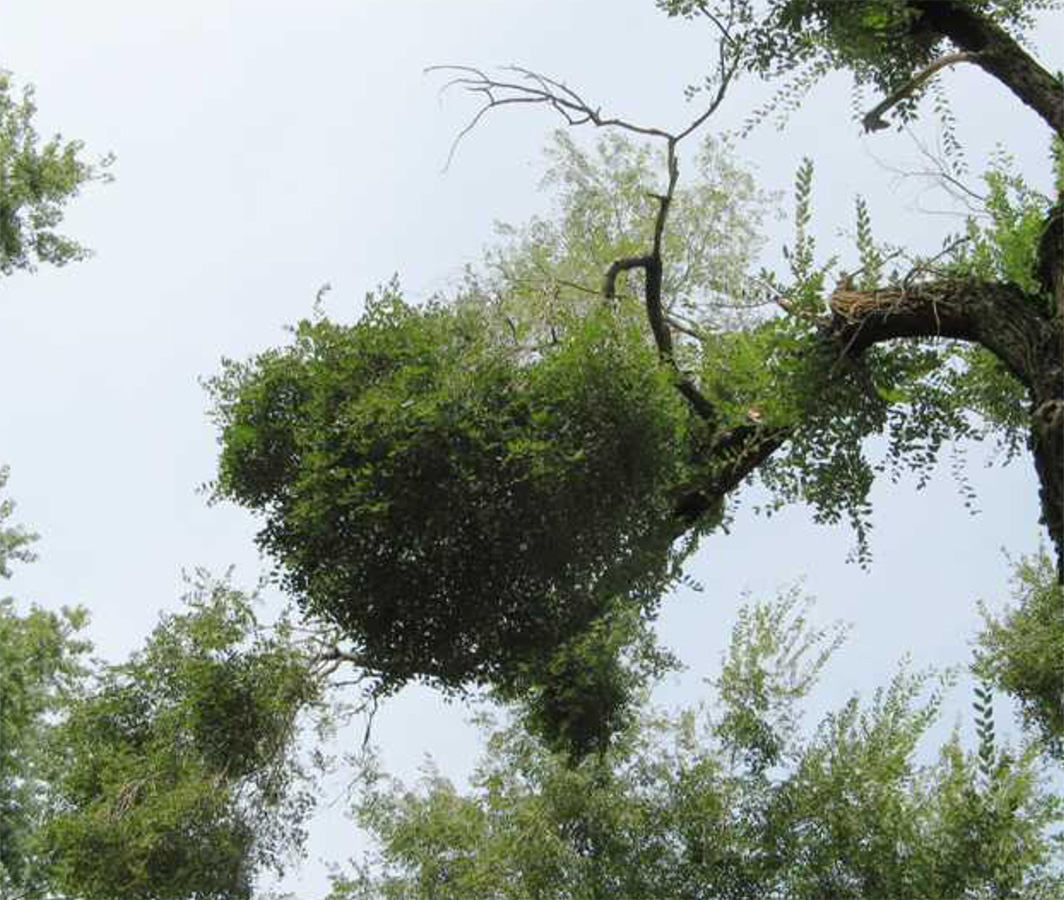 (Endnotes)
(Endnotes)
1. I don’t know whether my yatsubusa originated in a witches’ broom.
Although various causes for brooms on different species of trees have been identified the cause for the elm broom in the photo was not given. Witches’ broom can be caused by cytokinin, a phytohormone, interfering with an auxin-regulated bud. In normal plant function, auxin would keep the secondary, tertiary, and so on apices from overgrowing, but cytokinin can sometimes interfere with this control, causing these apices to grow into witch’s brooms. Grafting cuttings from these brooms onto a different root stock results in deformed trees. The only grafts I contemplated were inarch grafts using cuttings from the same genetic stock.
